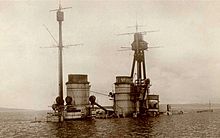SMS Hindenburg
|
||||||||||||||||||||
|
||||||||||||||||||||
|
||||||||||||||||||||
|
||||||||||||||||||||
SMS Hindenburg was a large cruiser ( battle cruiser ) of the Imperial Navy and the last of the three ships of the Derfflinger class . It was named after the then Field Marshal and later Reich President Paul von Hindenburg (1847–1934).
The ship was the replacement for the great cruiser Hertha . With 72,000 hp it had the most powerful engine power of all ships in the Imperial Navy. In the literature, the information on the maximum speed for miles varies between 26.6 and 27.0 knots. It should be taken into account that at the Hindenburg only so-called "war mile trips" with increased draft near the deployment displacement could take place, not as in peacetime with construction displacement on the staked mile from Neukrug near Danzig. In addition, these trips took place for miles in shallow water in the Bay of Kiel - which had a significant influence on the speed of the ship. However, over 95,000 WPS were achieved with overload . It can therefore be assumed that a comparable top speed - probably around 29 knots - would have been achieved as with the Seydlitz , which had a poorer length-width ratio and less power. The same problem also existed with the ratio of the maximum speeds of the Kaiser class to the König class .
Commissioned in May 1917, the Hindenburg came too late to take part in the last great naval battle of the First World War , the Skagerrak Battle .
On November 17, 1917, she was used as the flagship of the I. Reconnaissance Group together with the battle cruiser Moltke as remote security, but appeared too late on the scene to be able to actively participate in the naval battle near Heligoland , as the English withdrew.
After the end of the war, she was interned in Scapa Flow and sunk there by her crew on June 21, 1919 , when it became clear that the victorious powers would not surrender the German ships they had interned.
The ship sank on a level keel in shallow water and was still recognizable for years. After several unsuccessful attempts, the ship was lifted in 1930 and scrapped in Rosyth . The ship's bell was returned to Germany in 1936.
Commanders
| May 10 to December 1, 1917 | Sea captain Johannes von Karpf |
| December 1, 1917 to January 31, 1918 | Sea captain Hans Eberius |
| February 2 to December 3, 1918 | Sea captain Walter Hildebrand |
| until June 21, 1919 | Corvette Captain Erich Heyden |
Web links
- Film recordings of the Hindenburg , a. a. with scenes from the unsuccessful attempt at lifting in 1926 with completely preserved superstructures
- Film footage of the upscale Hindenburg from 1930
- Pictures of the Hindenburg
Individual evidence
- ↑ The Kieler Woche in progress , Baruther Anzeiger, August 20, 1936

